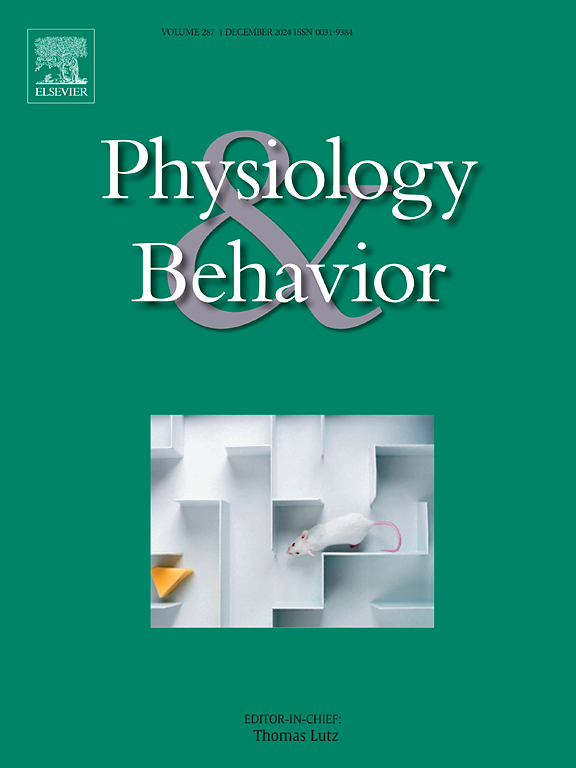The combination of citalopram and crocin synergistically alleviates the anxiogenic-related behaviors induced by acute restraint stress (ARS) in male mice
IF 2.5
3区 医学
Q2 BEHAVIORAL SCIENCES
引用次数: 0
Abstract
Citalopram, a selective serotonin reuptake inhibitor (SSRI), is well-known for the treatment of mood disorders and generalized anxiety disorder. Furthermore, crocin caused antidepressant impacts in clinical research and extensive anxiolytic impacts in experimental animal models. This research was designed to assess the effects of drug combinations of citalopram and crocin on anxiety-related behaviors induced by acute restraint stress (ARS) and aimed to discover the type of interaction between components. Acute restraint stress (ARS) was conducted by movement restraint for 4 hours. Anxiety-related behaviors were evaluated by elevated plus-maze (EPM). The results showed that induction of acute stress for 4 hours decreased the percent of open arm time (%OAT) and the percent of open arm entry (%OAE), showing anxiogenic-related behaviors. Intraperitoneal (i.p.) administration of citalopram (2 and 4 mg/kg) or crocin (40 mg/kg) induced anxiolytic-related behaviors in non-acute restraint stress (NARS) and ARS mice due to the enhancement of %OAT and %OAE. Additionally, i.p. co-injection of a sub-threshold dosage of citalopram (1 mg/kg) along with different dosages of crocin (10, 20, and 40 mg/kg) induced anxiolytic-related behaviors through augmentation of %OAT and %OAE. None of the above dosages of drugs changed the locomotor activity. Moreover, our results displayed a synergistic effect between citalopram and crocin on inducing anxiolytic-related behaviors in male mice. Our findings suggest that citalopram and crocin interact with each other for modulation of anxiety-related behaviors in the NARS and ARS mice.
西酞普兰与藏红花素联用可协同缓解雄性小鼠急性约束应激(ARS)诱导的焦虑相关行为
西酞普兰是一种选择性血清素再摄取抑制剂(SSRI),以治疗情绪障碍和广泛性焦虑症而闻名。此外,藏红花素在临床研究中具有抗抑郁作用,在实验动物模型中具有广泛的抗焦虑作用。本研究旨在评估西酞普兰和藏红花素联合用药对急性约束应激(ARS)诱导的焦虑相关行为的影响,并旨在发现组分之间的相互作用类型。急性约束应激(Acute restraint stress, ARS)采用运动约束4 h。采用升高+迷宫法(EPM)评估焦虑相关行为。结果表明,急性应激诱导4小时使大鼠张开臂时间百分比(%OAT)和张开臂进入百分比(%OAE)下降,表现出焦虑相关行为。腹腔注射西酞普兰(2和4 mg/kg)或藏红花素(40 mg/kg)可通过提高%OAT和%OAE,诱导非急性约束应激(NARS)和ARS小鼠的焦虑相关行为。此外,腹腔注射低于阈值剂量的西酞普兰(1mg /kg)和不同剂量的藏花素(10mg /kg、20mg /kg和40mg /kg)通过增加%OAT和%OAE诱导焦虑相关行为。上述剂量的药物均未改变运动活动。此外,我们的研究结果显示西酞普兰和藏红花素在诱导雄性小鼠焦虑相关行为方面具有协同作用。我们的研究结果表明,西酞普兰和藏红花素相互作用,以调节NARS和ARS小鼠的焦虑相关行为。
本文章由计算机程序翻译,如有差异,请以英文原文为准。
求助全文
约1分钟内获得全文
求助全文
来源期刊

Physiology & Behavior
医学-行为科学
CiteScore
5.70
自引率
3.40%
发文量
274
审稿时长
47 days
期刊介绍:
Physiology & Behavior is aimed at the causal physiological mechanisms of behavior and its modulation by environmental factors. The journal invites original reports in the broad area of behavioral and cognitive neuroscience, in which at least one variable is physiological and the primary emphasis and theoretical context are behavioral. The range of subjects includes behavioral neuroendocrinology, psychoneuroimmunology, learning and memory, ingestion, social behavior, and studies related to the mechanisms of psychopathology. Contemporary reviews and theoretical articles are welcomed and the Editors invite such proposals from interested authors.
 求助内容:
求助内容: 应助结果提醒方式:
应助结果提醒方式:


